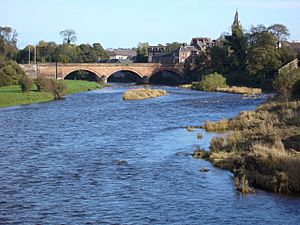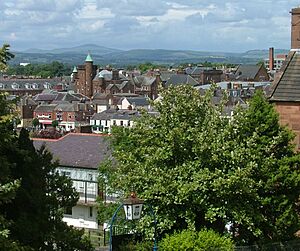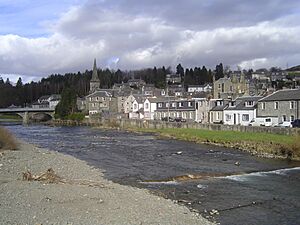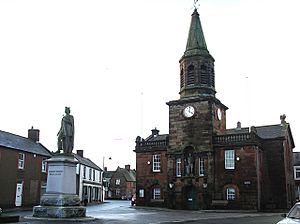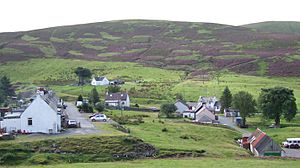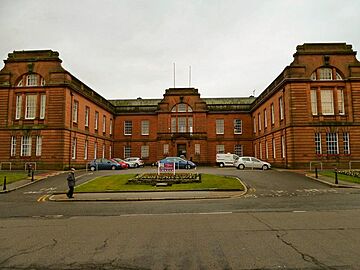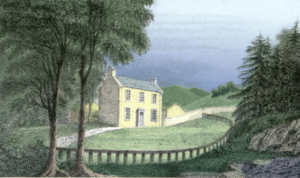Dumfriesshire facts for kids
Quick facts for kids
Dumfriesshire
|
|
|---|---|
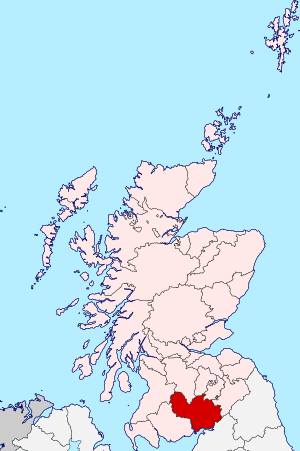 |
|
| Country | Scotland |
| County town | Dumfries |
| Area | |
| • Total | 1,063 sq mi (2,753 km2) |
| Ranked 8th of 34 | |
| Chapman code |
DFS
|
Dumfriesshire (Scottish Gaelic: Siorrachd Dhùn Phris) is a historic county in southern Scotland. It's also known as the County of Dumfries or Shire of Dumfries. A "historic county" is an old way of dividing up land. The Dumfries area today covers a similar region.
This historic county shares borders with other areas. To the west, it meets Kirkcudbrightshire. To the north-west, it borders Ayrshire. Lanarkshire, Peeblesshire, and Selkirkshire are to its north. To the east, you'll find Roxburghshire. To the south, Dumfriesshire has a coastline along the Solway Firth, which is a bay, and it touches the English county of Cumberland.
Dumfriesshire has three main parts, named after its river valleys: Annandale, Eskdale, and Nithsdale. These areas used to be separate regions in medieval times. From 1890 to 1975, Dumfriesshire had its own local government called the County Council. Since 1975, this area has been part of the larger Dumfries and Galloway council area.
Contents
- Exploring Dumfriesshire's Landscape
- Dumfriesshire's Rocks and Land Formation
- Weather, Farming, and Jobs
- Getting Around Dumfriesshire
- Towns and Villages in Dumfriesshire
- A Look Back at Dumfriesshire's Past
- Historical Population Figures
- Fun Things to Do in Dumfriesshire
- Well-Known People from Dumfriesshire
- Images for kids
- See also
Exploring Dumfriesshire's Landscape
Dumfriesshire's coastline stretches for about 21 miles (34 km). The land gently slopes from the northern mountains, part of the Southern Uplands, down to the sea. You'll find tall hills mixed with flat areas or rich, fertile river plains. Near the Solway Firth, there are also areas of marshland, like Lochar Moss, which were once underwater but have now been mostly reclaimed for use.
The highest mountains are in the north. Some of these include White Coomb (2,695 ft (821 m)), Hart Fell (2,651 ft (808 m)), and Queensbury (2,285 ft (696 m)).
Rivers and Valleys
The three longest rivers are the River Nith, the River Annan, and the River Esk. These rivers flow through large valleys that cut through the county from north to south. These valleys are called Nithsdale, Annandale, and Eskdale.
The Nith river flows mostly south-east until it reaches the Solway Firth. Its total length is 65 miles. The Annan river starts near a famous deep hole called the Devil's Beef Tub.
It flows south for about 40 miles (64 km) before entering the Solway. The Esk river is formed by two smaller rivers, the White Esk and the Black Esk. It flows south-east and then south-west, forming part of the border with England.
Other rivers in Dumfriesshire include the Lochar Water, the Kirtle Water, and the River Sark. All of these flow into the Solway Firth. For a short distance, the Esk and Sark rivers form part of the border between Dumfriesshire and Cumberland in England. Between the Esk and Sark is Scots' Dyke, a human-made mound that marks the border.
Lakes and Waterfalls
Loch Skeen in the north is a main lake, located 1,750 feet (530 m) above sea level. There are also several lakes around Lochmaben. While there aren't many places officially called "glens" (narrow valleys), the passes of Dalveen, Enterkin, and Menock offer stunning mountain views.
The Enterkin Pass runs between mountains that rise almost 2,000 ft (610 m) straight up from the stream below. Loch Skeen flows into Tail Burn, which then drops 200 ft (61 m) to create a beautiful waterfall called the Grey Mare's Tail. Another smaller, pretty waterfall with the same name is found near Thornhill. You can also find natural mineral water springs at places like Moffat and Brow.
Dumfriesshire's Rocks and Land Formation
Most of Dumfriesshire is made up of very old rocks from the Silurian period. These rocks include different types like grits, shales, and greywackes. They show many folds and layers, meaning the land has been pushed and squeezed over millions of years.
In some areas, you can find even older rocks from the Arenig, Llandeilo, and Caradoc periods. These rocks contain fossils of tiny sea creatures called graptolites. For example, in Moffatdale, famous sections of these rocks were studied by a scientist named Charles Lapworth.
There are also younger rocks from the Old Red Sandstone period and the Carboniferous period. The Carboniferous rocks are important because they contain valuable coal seams, especially in the Sanquhar area. These coal seams are similar to those found in Ayrshire.
Even younger rocks from the Triassic period are found in several areas, including near Annan and Dumfries. These rocks include sandstones that are used for building. In the sandstones of Corncockle Moor, scientists have even found footprints of ancient reptiles!
Weather, Farming, and Jobs
Dumfriesshire has a mild climate. The average temperature for the year is about 9 °C (48 °F). It gets about 53 inches of rain each year.
Farming and Animals
Around the mid-1700s, farmers in Dumfriesshire started raising animals to sell in the south. A hundred years later, about 20,000 large cattle were sent to English markets every year. While Galloway cattle were popular at first, farmers now mostly raise shorthorns and Ayrshire dairy cows.
Raising Sheep became very important later on. In the higher hills, you'll find Cheviots. In the richer, lower pastures, farmers raise "half-bred" lambs, which are a mix of Cheviots and other types of sheep. Pig farming used to be big but has become less common. Horse breeding is also done quite a lot. Farmers grow grain crops, mainly oats, but this has been decreasing. Farms range in size from 100–300 acres (0.40–1.21 km2) for growing crops to 300–3,000 acres (1.2–12.1 km2) for raising animals.
Local Industries
Most of the industries in Dumfriesshire are small and serve the local area. They are mainly found in Dumfries and a few larger towns. Langholm is known for its tweed fabric. You can find breweries and distilleries in places like Annan and Sanquhar. Some shipping happens at Annan and Dumfries. The salmon fishing in the Nith and Annan rivers and the Solway Firth is also important.
Getting Around Dumfriesshire
Several railway lines used to run through Dumfriesshire. The Glasgow and South Western Railway went from Glasgow to Carlisle, passing through Nithsdale and Annandale. A branch line from Dumfries to Moniaive closed in 1949.
The Caledonian Railway also connected Carlisle to Glasgow through Annandale. It had a small branch to Moffat, which is now closed. Other lines from Lockerbie and Kirtlebridge also closed.
West of Dumfries, there were rail connections to places like Castle Douglas and Stranraer, but these lines have also closed and the tracks removed. The North British Railway's Waverley Line from Carlisle to Edinburgh closed in the 1960s. There are talks about possibly reopening part of this line. A short line to Langholm also closed in 1967.
Today, there's a large network of local buses and coaches, mainly based in Dumfries. There are no commercial airports in the county.
Towns and Villages in Dumfriesshire
Here are some of the towns and villages you can find in Dumfriesshire:
- Annan
- Beattock
- Canonbie
- Closeburn
- Dumfries
- Dunscore
- Ecclefechan
- Gretna
- Gretna Green
- Johnstonebridge
- Kirkconnel
- Langholm
- Lochmaben
- Lockerbie
- Moffat
- Ruthwell
- Sanquhar
- Thornhill
- Wanlockhead
A Look Back at Dumfriesshire's Past
People have lived in Dumfriesshire for a very long time. We know this from ancient remains like stone circles and burial mounds from the Stone Age and Bronze Age.
The Romans called the local tribe the Selgovae. They left behind many signs of their presence, such as hill forts and camps. The ruins of Blatobulgium at Birrens are a great example of a Roman camp. Roman items like altars, urns, and coins have been found in many places.
After the Romans left Britain, the area's history becomes less clear. Different groups, including people from Strathclyde, Scots from Ireland, and Angles from Northumberland, influenced the region.
Important Historical Events
In the church at Ruthwell, you can see an ancient Anglo-Saxon cross. This cross has Runic writing that tells the story of the Crucifixion.
Because Dumfriesshire was a "Border county," it saw many exciting and sometimes violent events. This was especially true during the time of Robert Bruce. Edward I even attacked Caerlaverock Castle. Local families, called Border clans, were often fighting. For example, in 1593, the Johnstones fought the Maxwells in Dryfesdale, a very bloody battle. These family feuds continued for a long time.
The hills of Dumfriesshire also offered a safe place for the Covenanters, a religious group who were persecuted. In Sanquhar in 1680, they made a famous statement against the king.
Famous People from Dumfriesshire
Dumfriesshire is closely linked to the famous Scottish poet Robert Burns. He lived and farmed at Ellisland Farm for three years and spent his last five years in Dumfries.
Thomas Carlyle, a well-known writer, was born in Ecclefechan. His farm, Craigenputtock, was later given to Edinburgh University to help students.
Local stories say that at Holywood, near Dumfries, there's a leftover part of a sacred oak grove and a stone circle called the Twelve Apostles.
In 1988, a terrible event happened in Dumfriesshire. A bomb exploded on an airplane flying over the town of Lockerbie. This event, known as the Lockerbie bombing, sadly killed 270 people. It remains the worst terrorist attack in British history.
How Dumfriesshire Was Governed
Dumfriesshire has been a county since at least 1305. For a long time, the areas of Annandale and Eskdale had some independence. However, by 1747, the whole area was under the control of the sheriff of Dumfries.
From 1890, Dumfriesshire had a County Council that managed local affairs. This council was based at County Buildings in English Street. In 1975, the County Council was replaced. Its duties were taken over by the larger Dumfries and Galloway Regional Council. Today, the area is part of the Dumfries and Galloway Council.
Historical Population Figures
Here's how the population of Dumfriesshire and its main towns changed over time:
In 1891, the total population was 74,245. In 1901, it was 72,371. At that time, 176 people spoke both Gaelic and English.
- Annan: 4,309 (1901), 4,631 (1951), 8,389 (2001)
- Dumfries: 14,440 (1901), 26,322 (1951), 37,846 (2001)
- Langholm: 3,142 (1901), 2,404 (1951), 2,311 (2001)
- Lockerbie: 2,358 (1901), 2,621 (1951), 4,009 (2001)
- Moffat: 2,530 (1901), 2,114 (1951)
Fun Things to Do in Dumfriesshire
Places to Visit
- Caerlaverock Castle: A cool, old castle with a unique triangular shape.
- Dumfries Museum: Learn about the history of the area.
- Sweetheart Abbey: The beautiful ruins of an old abbey.
Outdoor Adventures
Dumfriesshire is a great place for outdoor activities!
- Mountain Biking: It has three world-class 7Stanes mountain biking centers at Dalbeattie, Mabie, and Ae.
- Cycling: The Sustrans Route 7, a long-distance cycle path, goes through Dumfriesshire.
- Hill Walking: The Moffat Hills offer excellent places for hiking.
- Long-Distance Walks: The Southern Upland Way (a coast-to-coast walk) passes through the county. The 53 mi (85 km) long Annandale Way also takes you from the Solway Firth into the Moffat hills.
- Sailing: You can go sailing on Castle Loch at Lochmaben.
Well-Known People from Dumfriesshire
Many notable people have come from Dumfriesshire, including:
- Thomas Carlyle: A famous essayist and writer.
- Henry Duncan: A clergyman who helped start savings banks.
- Andy Goldsworthy: A well-known sculptor who creates art using natural materials.
- William Jardine: A surgeon who co-founded the large company Jardine Matheson.
- Kirkpatrick Macmillan: Often credited with inventing the first pedal bicycle.
- William Paterson: A banker who helped found the Bank of England.
- Thomas Telford: A famous engineer who built roads, bridges, and canals.
- Joseph Thomson: A geologist and explorer.
- John Laurie: An actor, famous for playing Private Frazer in the TV show Dad's Army.
- Jane Haining: A Church of Scotland missionary who was tragically killed by Nazis for helping Jewish people during the Holocaust.
Images for kids
See also
 In Spanish: Dumfriesshire para niños
In Spanish: Dumfriesshire para niños





